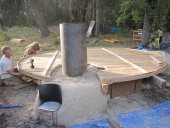





 1
1




For all your Montana Masonry Heater parts (also known as) Rocket Mass heater parts.
Visit me at
dragontechrmh.com Once you go brick you will never go back!
 2
2




 2
2




regards, Peter
 1
1




















Success has a Thousand Fathers , Failure is an Orphan
LOOK AT THE " SIMILAR THREADS " BELOW !




 1
1




Why do you feel safe when mankind has only proven to be able to survive 12,000 years at a stretch...? Be prepared for the next probable end: http://www.teomcrote.co.nf
Security: Rhodesian Ridgeback; Animals: Scobies and rabbits; Diet: Born to Run; Religion: trust no one; my best posts/replies so far
 1
1




Socrates Raramuri wrote:Sand?
I thought about this, as well, and watching one video it was mentioned that someone used sand as part of the mass but that this was inappropriate because sand insulates... So there ya go, i thought.
Would it be the best insulator? Probably not. But it's everywhere and free. And often 'the best' can be substituted by simply applying more of what might seem an inferior product.


|
No more fooling around. Read this tiny ad:
Learn Permaculture through a little hard work
https://wheaton-labs.com/bootcamp
|


